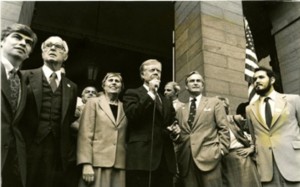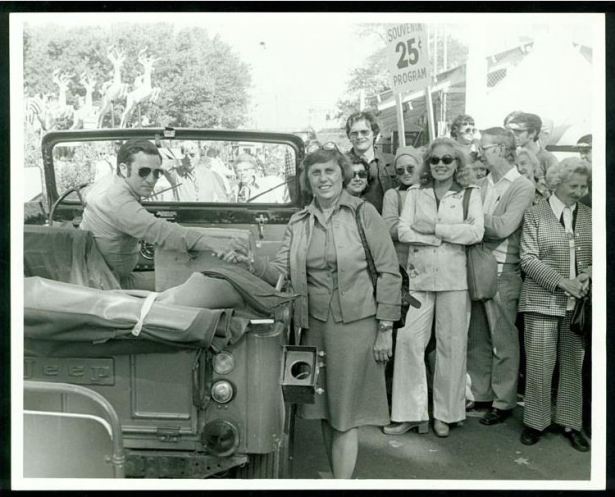By Mary Muller for Your Public Media
Ella Tambussi Grasso was born to Italian immigrant parents in Windsor Locks, Connecticut, on May 10, 1919. She attended the Chaffee School in Windsor and earned a scholarship to Mount Holyoke College where she earned both BA (1940) and MA (1942) degrees. At an early age, she displayed an interest and belief in public service and, soon after completing her education, became involved in the Democratic Party in Connecticut. She was first elected to the state General Assembly in 1952. In nine subsequent state and federal elections, she was never defeated. She also served two terms in the US House of Representatives but was soon drawn back to Connecticut state politics. She kept a sign in her living room that read, “Bloom Where You Are Planted.”

Governor Ella Grasso with Christopher Dodd, Abraham Ribicoff, Jimmy Carter and Wilson Wilde, ca. 1975-1980, photograph by Charles William Eldridge – Connecticut Historical Society
In 1975, Grasso became Connecticut’s first woman governor and first governor of Italian descent. She was also the first woman in the United States to become governor in her own right, that is, not as a successor to her husband. A smart, tough, and hard-working politician, she confronted many issues that are familiar to us today. Budget shortfalls, resulting in the need to increase taxes and lay off state workers, made her first years in office difficult. An improving national economy and the inauguration of the Connecticut State Lottery in 1976 helped turn things around.
Grasso’s timely, personal and hands-on response to the Blizzard of 1978 solidified her popularity and resulted in a huge reelection victory the following November. By the beginning of her second term, the state had a budget surplus, and Grasso was able to fund many social programs including aid to impoverished communities, housing, mass transit, day care, and assistance for the elderly.
Grasso was diagnosed with ovarian cancer during the spring of 1980 and her declining health forced her to resign on December 31 of that year. She died at Hartford Hospital on February 5, 1981. She is buried in Saint Mary’s Cemetery in Windsor Locks. Women politicians were a rare thing in Grasso’s day. Though women are much more prominent in politics today, Grasso continues to serve as an inspiration and a role model. Jon E. Pumont, Grasso’s executive assistant when she was governor, published a biography of her, Ella Grasso, Connecticut’s Pioneering Governor, in 2012.
Mary Muller is the Lead Museum Educator at the Connecticut Historical Society.
© Connecticut Public Broadcasting Network and Connecticut Historical Society. All rights reserved. This article originally appeared on Your Public Media.
Note: ConnecticutHistory.org does not edit content originally published on another platform and therefore does not update any instances of outdated content or language.









